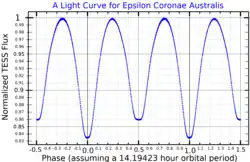Epsilon Coronae Australis
Epsilon Coronae Australis (ε CrA), is a star system located in the constellation Corona Australis. Varying in brightness between apparent magnitudes of 4.74 to 5 over 14 hours, it is the brightest W Ursae Majoris variable (low mass contact binary) in the night sky.
| Observation data Epoch J2000 Equinox J2000 | |
|---|---|
| Constellation | Corona Australis |
| Right ascension | 18h 58m 43.37714s[2] |
| Declination | −37° 06′ 26.4865″[2] |
| Apparent magnitude (V) | +4.75[3] |
| Characteristics | |
| Spectral type | F4V Fe-0.8[4] |
| U−B color index | +0.01[3] |
| B−V color index | +0.39[3] |
| Variable type | W UMa[5] |
| Astrometry | |
| Radial velocity (Rv) | 57.90 ± 1.2[6] km/s |
| Proper motion (μ) | RA: −132.40[2] mas/yr Dec.: −110.62[2] mas/yr |
| Parallax (π) | 33.13 ± 0.33 mas[2] |
| Distance | 98.4 ± 1.0 ly (30.2 ± 0.3 pc) |
| Absolute magnitude (MV) | 2.21[7] |
| Orbit[8] | |
| Period (P) | 0.59143357 ± 0.00000016 d |
| Semi-major axis (a) | 3.795 ± 0.052 R☉ |
| Eccentricity (e) | 0 |
| Inclination (i) | 73.05 ± 0.16° |
| Longitude of the node (Ω) | 2.0113 ± 0.0033° |
| Periastron epoch (T) | JD 2442296.95907 ± 0.0070 |
| Details | |
| ε CrA A | |
| Mass | 1.9[8] M☉ |
| Radius | 2.167[8][note 1] R☉ |
| Temperature | 6481 ± 20[8] K |
| Rotational velocity (v sin i) | 148.5[9] km/s |
| ε CrA B | |
| Mass | 0.24[8] M☉ |
| Radius | 0.869[8][note 1] R☉ |
| Temperature | 5939 ± 19[8] K |
| Other designations | |
| Database references | |
| SIMBAD | data |
Naming
Nicolas Louis de Lacaille gave Epsilon Coronae Australis its Bayer designation. It is also known as HR 7152, and HD 175813.
Properties
Epsilon Coronae Australis is an F4V dwarf star with an effective temperature of 6000 Kelvin. It ranges between apparent magnitudes of 4.74 to 5 over 14 hours,[10] an absolute magnitude of +2.45, and a mass of 1.1 solar masses. Epsilon Coronae Australis is a W Ursae Majoris variable, indicating that it has a contact companion within the Roche limit of the primary. The star is located at a distance of 30 pc (97 light years) from the Sun.[7] Yildiz and colleagues estimated the age of the system at 2.83 ± 0.28 billion years based on study of the properties of the system and estimated rate of mass transfer. They found the current masses of the primary and secondary to be 1.72 ± 0.04 and 0.22 ± 0.02 solar masses respectively, from their original masses of 1.06 ± 0.03 and 2.18 ± 0.06 solar masses.[11]
Notes
- Radii were given as a ratio of the radius to the semi-major axis; the semi-major axis is 3.795 R☉.
References
- "MAST: Barbara A. Mikulski Archive for Space Telescopes". Space Telescope Science Institute. Retrieved 8 December 2021.
- van Leeuwen, F.; et al. (2007). "Validation of the new Hipparcos reduction". Astronomy and Astrophysics. 474 (2): 653–664. arXiv:0708.1752. Bibcode:2007A&A...474..653V. doi:10.1051/0004-6361:20078357. S2CID 18759600.
- Mermilliod, J.-C. (1986). "Compilation of Eggen's UBV data, transformed to UBV (unpublished)". Catalogue of Eggen's UBV Data. Bibcode:1986EgUBV........0M.
- Gray, R. O.; Corbally, C. J.; Garrison, R. F.; McFadden, M. T.; Bubar, E. J.; McGahee, C. E.; O'Donoghue, A. A.; Knox, E. R. (2006). "Contributions to the Nearby Stars (NStars) Project: Spectroscopy of Stars Earlier than M0 within 40 pc--The Southern Sample". The Astronomical Journal. 132 (1): 161–170. arXiv:astro-ph/0603770. Bibcode:2006AJ....132..161G. doi:10.1086/504637. S2CID 119476992.
- "* eps CrA". SIMBAD. Centre de données astronomiques de Strasbourg. Retrieved 13 March 2017.
- Bilir, S.; Karataş, Y.; Demircan, O.; Eker, Z. (2005). "Kinematics of W Ursae Majoris type binaries and evidence of the two types of formation". Monthly Notices of the Royal Astronomical Society. 357 (2): 497–517. arXiv:astro-ph/0411291. Bibcode:2005MNRAS.357..497B. doi:10.1111/j.1365-2966.2005.08609.x. S2CID 16274339.
- Eker, Z.; Bilir, S.; Yaz, E.; Demircan, O.; Helvaci, M. (2009). "New absolute magnitude calibrations for W Ursa Majoris type binaries". Astronomische Nachrichten. 330 (1): 68–77. arXiv:0807.4989. Bibcode:2009AN....330...68E. doi:10.1002/asna.200811041. S2CID 15071352.
- Wilson, R. E.; Raichur, H. (2011). "Distance and temperature from absolute light curves of three eclipsing binaries". Monthly Notices of the Royal Astronomical Society. 415 (1): 596–604. Bibcode:2011MNRAS.415..596W. doi:10.1111/j.1365-2966.2011.18741.x.
- Schröder, C.; Reiners, Ansgar; Schmitt, Jürgen H. M. M. (January 2009), "Ca II HK emission in rapidly rotating stars. Evidence for an onset of the solar-type dynamo" (PDF), Astronomy and Astrophysics, 493 (3): 1099–1107, Bibcode:2009A&A...493.1099S, doi:10.1051/0004-6361:200810377
- BSJ (4 January 2010). "Epsilon Coronae Australis". AAVSO Website. American Association of Variable Star Observers. Retrieved 22 January 2014.
- Yildiz (2014). "Origin of W UMa-type contact binaries - age and orbital evolution". Monthly Notices of the Royal Astronomical Society. 437 (1): 185–94. arXiv:1310.5526. Bibcode:2014MNRAS.437..185Y. doi:10.1093/mnras/stt1874.
